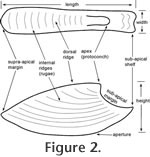|
|
|
MATERIALS AND METHODSThe specimens of Mellopegma georginense Runnegar and Jell, 1976, Mellopegma simesi (MacKinnon 1985) comb. nov., Mellopegma schizocheras sp. nov., and Acanthotheca junior (Runnegar 1996) gen. nov. described herein are from the Gowers Formation (originally Currant Bush Limestone) in the eastern Georgina Basin, western Queensland, Australia (collected by SMP and A. Knoll in 1998). The localities from which these specimens were collected are shown in Vendrasco et al. (2010, figure 1b). The Gowers Formation has a diverse, exceptionally preserved phosphatic microfossil assemblage (Shergold and Laurie 1986) with a rich molluscan fauna (Runnegar and Jell 1976). Mellopegma is by far the most common mollusc and often the most conspicuous fossil in many of these beds, co-occurring with the molluscs Pelagiella, Yochelcionella, Eotebenna, Pseudomyona, Protowenella, and others (Vendrasco et al. 2010). The specimens of Mellopegma uslonicum Parkhaev, 2004 discussed here are from the uppermost Emyaksin Formation, Bergeroniellus micmacciformis Biozone of the earliest Botoman Stage, from the eastern flanks of the Anabar Uplift of the Siberian Platform. They are from: sample 1420, locality A-53, right bank of the Bol'shaya Kuonamka River, 1-2 km downstream from the Ulakhan-Tyulen' Brook (Valkov 1975); and sample 7/70, locality 96-7, left bank of the Bol'shaya Kuonamka River, ~ 3 km downstream from the mouth of the Ulakhan-Tyulen' Brook (collected by AVK in 1996). Mellopegma indecorum (Missarzhevsky in Rozanov et al. 1969) has been recovered from a few early Cambrian localities on the Siberian Platform. Specimens from sample 183e (locality 183) were collected by V.E. Savitzky from the Kyndyn Formation that cropped out at the left bank of the Rassokha River, ~ 3.5 km upstream from the Sakha-Yurege Rivulet, northern flanks of the Anabar Uplift, Siberia (Egorova and Savitzky 1969, figure 3). These beds are assigned to the Tommotian Stage, Dokidocyathus regularis Biozone (according to Rozanov et al. 1969, p. 144). Specimens from sample M303/2 are from the Pestrotsvet Formation, Dokidocyathus regularis Biozone (Rozanov et al. 1969), left bank of the middle Lena River, 14 km downstream from the Malykan River, at the mouth of the Tiktirikteekh Brook (Shabanov et al. 2008, p. 67). The specimens of Stenotheca drepanoida (He and Pei in He et al. 1984) are from the early Cambrian Ajax and Parara Limestones of the Mount Scott Range in the Flinders Ranges, South Australia (collected by B. Runnegar and S. Bengtson), University of New England, Armidale Localities (UNEL) 1876 (=1766C), 1852, and 1874 (Bengtson et al. 1990). The Ajax Limestone likely correlates with the Botoman Stage (Jago et al. 2006; Paterson and Brock 2007). One specimen that may be S. drepanoida has been found in Missarzhevsky's collection labeled GIN 3593/540, locality indicated as middle Lena River, probably locality M303/2 (Rozanov et al. 1969). The specimens of Mellopegma georginense, M. simesi, M. schizoceras, and Acanthotheca junior from the Gowers Formation of Australia were extracted from the carbonate matrix with 10-15% acetic acid, sorted, and placed on SEM stubs. They were gold coated and photographed with a Zeiss EVO XVP scanning electron microscope (SEM) at the Santa Barbara Museum of Natural History (SBMNH). Specimens of Mellopegma uslonicum and Mellopegma indecorum were obtained from the collections of V.V. Missarzhevsky, V.E. Savitzky, A.K. Valkov, and AVK, having been isolated from the limestone matrix with a buffered solution of ~10% acetic acid, gold coated, and photographed with a Hitachi S-4300 FE-SEM at the Swedish Museum of Natural History (SMNH). Specimens of S. drepanoida were sorted from acid macerates processed by B. Runnegar and S. Bengtson and were examined via the two microscopes listed above. Images were taken at a variety of voltages (15–30 kV; higher voltage used at greater magnification), typically using secondary electron detectors but occasionally backscatter or variable pressure detectors when charging occurred. Measurements were made from digital SEM photographs using ImageJ (Rasband 1997–2009). All specimens of Mellopegma georginense Runnegar and Jell, 1976, M. schizocheras sp. nov., M. simesi, and Acanthotheca junior gen. nov. are reposited at the Commonwealth Palaeontological Collections (CPC), Geoscience Australia, Canberra. Specimens of M. indecorum (Missarzhevsky in Rozanov et al. 1969), S. drepanoida and M. uslonicum are reposited at the Swedish Museum of Natural History (SMNH).
The analyses of damage and repair frequencies in stenothecids through time were based on three datasets. The first consisted of data from specimens of Stenotheca Salter in
Hicks, 1872 and Anabarella
Vostokova, 1962 from the early Cambrian Parara Limestone localities L1763C, L1852, and L1853, South Australia (Bengtson et al. 1990). Samples from these localities were combined so that the number of specimens would be roughly comparable to those from the other two datasets. Damage proportions for each sample were the same as that for the composite sample, so this approach should not affect the analysis. The second and third datasets consisted of Mellopegma specimens collected from a bed at the base of the middle Cambrian Gowers Formation, Queensland, and a bed about 50 cm above it.
The cladistic analysis was constructed with PAUP 4.0b10 (Swofford 2002). All 21 characters were weighted equally and all character states unordered. Oelandiella korobkovi Vostokova, 1962 was used as the outgroup because its shell morphology is well known, it is the oldest helcionellid from Siberia (Gubanov and Peel 1999), and it is somewhat laterally compressed (although not to the same extent as in stenothecids) and thus it may represent the ancestral state of stenothecids. An exhaustive search was completed using maximum parsimony. The typical form of Mellopegma and the key terms used here are illustrated in Figure 2. |
|
